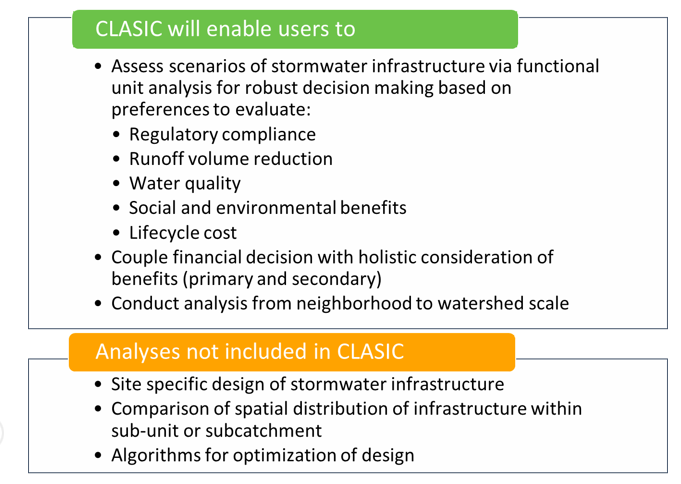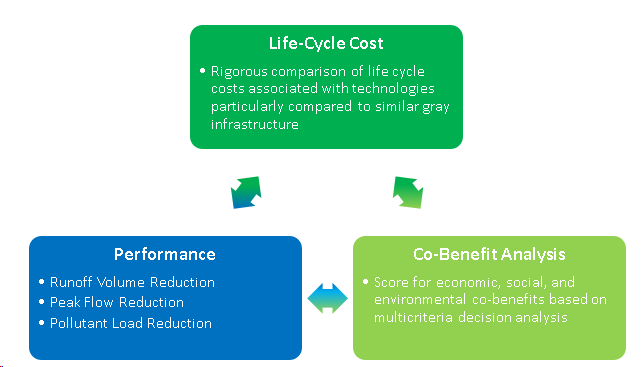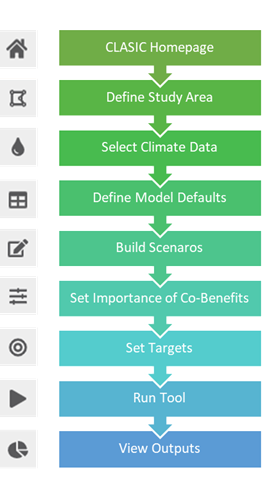Documentation

Community-enabled Lifecycle Analysis of Stormwater Infrastructure Costs (CLASIC)
Purpose of CLASIC
The CLASIC tool is a screening tool utilizing a lifecycle cost framework to support stormwater infrastructure decisions on extent and combinations of green, hybrid green-gray and gray infrastructure practices. Users can create scenarios of stormwater control measures including climate and land use projections to assess lifecycle costs, performance, and co-benefits associated with those scenarios.
CLASIC Functions
CLASIC is a screening tool and is not intended for optimization of design. The scope of CLASIC is shown in Figure 1.

CLASIC Tool Components
There are three main components to the CLASIC tool outputs: life cycle costs (LCC), Co-benefits and performance (Figure 2).
Life Cycle Cost – The LCC is structured to provide feasibility level municipal budget estimates over time for a variety of SCM construction and maintenance costs.
Performance – Performance of scenarios will be estimated in terms of hydrology (e.g. peak runoff and volume reduction) and pollutant load reduction.
Co-Benefits - The co-benefits analysis will be informed via multi-criteria decision analysis (MCDA) output. The MCDA provides quantitative output to compare co-benefits across scenarios of technology selection.
These three components of outputs are intended to work in tandem to inform decisions on scenarios. When a user views outputs, the user will have the option to create new scenarios based on knowledge gained from the previous scenario outputs.

CLASIC Tool Steps
After you register for an account and/or login, icons will appear on the left to guide you through the steps of the CLASIC tool (Figure 3). Click on the Select Area icon on the left panel to get started.

User Guide
Download the user guide.
Guidance for Quick Runs
- The duration of precipitation data impacts CLASIC processing time. To decrease processing time, select a duration of precipitation data less than 10 years.
- Including a large number of subunits in your project selection area and/or adding a large number of technologies to a scenario can result in a long processing time. To decrease processing time, consider creating project areas with less than 10 subunits and/or scenarios that include less than 5 added stormwater technologies.
- When a project is created as a single subunit, the precipitation duration and number of technologies may be increased while still maintaining shorter processing times.
Case Study Applications
CLASIC Case Studies showcase the variety of ways that the web-based Community-enabled Lifecycle Analysis of Stormwater Infrastructure Cost (CLASIC) Tool can assist communities with stormwater project planning and decision making.
- Combination Gray and Green Infrastructure Scenarios - Oxford, MS
- GI Technology Scenarios and Climate Impacts - Dubuque, IA
- Redevelopment Gray and Greener Stormwater Options - Kirkland, WA
- GI on Vacant Lots and Tree Installation: Cost and Co-benefits - Kansas City, MO
- Projects in Small Communities - Harvey, ND
- Stormwater Technology Hydrologic Performance in Redevelopment Areas - Carmel, IN
- Technology Performance Examples by Subunits - Savannah, GA
- Scenario Performance in Future Climate Scenarios - San Diego, CA
- Considerations of Progressive Greening in a Co-benefit Analysis - Philadelphia, PA
- Upgrading Existing Stormwater Infrastructure to Enhance Receiving Waterbody Benefits - Fort Collins, CO
Acknowledgements

Copyright © 2021, The Water Research Foundation, ALL RIGHTS RESERVED
Disclaimer: This tool was prepared by Colorado State University One Water Solutions Institute as an account of work sponsored by The Water Research Foundation. Neither The Water Research Foundation, members of The Water Research Foundation, the organization(s) named above, nor any person acting on their behalf: (a) makes any warranty, express or implied, with respect to the use of any information, apparatus, method, or process disclosed in this tool or that such use may not infringe on privately owned rights; or (b) assumes any liabilities with respect to the use of, or for damages resulting from the use of, any information, apparatus, method, or process disclosed in this tool.
